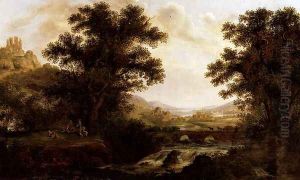James Lambert Paintings
James Lambert was an English painter born in 1725, known primarily for his work as a landscape artist. His life and career were rooted in the artistic traditions of the 18th century, a period that saw significant developments in the landscape genre. Lambert hailed from Lewes in East Sussex, a location that would provide much of the inspiration for his bucolic and serene landscapes. Despite the lack of comprehensive records about his personal life, Lambert's artistic contributions have been pieced together through his surviving works and the modest documentation that does exist.
Educationally, it is believed that Lambert received no formal art training, a common scenario for many artists of his time who often learned through apprenticeships or were largely self-taught. Lambert, however, showed an innate talent for capturing the essence of the English countryside, imbuing his canvases with a sense of realism and emotional depth that resonated with viewers. His ability to depict the natural beauty of his surroundings without idealization set him apart from many of his contemporaries.
Throughout his career, James Lambert remained relatively local, drawing from the landscapes around Sussex and the South Downs. These regions offered a wealth of natural beauty and variance, which Lambert skillfully translated onto canvas. His works often featured pastoral scenes, with detailed renderings of the flora and fauna, under expansive and expressive skies. Not bound by the grandeur of sublime landscapes that were popular among some of his peers, Lambert's paintings instead celebrated the quiet, everyday beauty of rural England.
Lambert's contributions to English art, though perhaps not as widely recognized as those of his more famous contemporaries, are nonetheless significant. He played a part in the evolution of landscape painting, moving it towards more naturalistic and intimate depictions. His works serve as historical documents that offer insights into the English countryside of the 18th century, reflecting both the beauty of the landscape and the cultural attitudes toward nature during that period.
James Lambert died in 1788, leaving behind a modest but important body of work. His paintings continue to be appreciated for their tranquil beauty and historical value, offering viewers a glimpse into the pastoral life of 18th-century England. Through exhibitions and auctions, Lambert's legacy as a landscape painter has been preserved, ensuring his place within the broader narrative of English art history.
